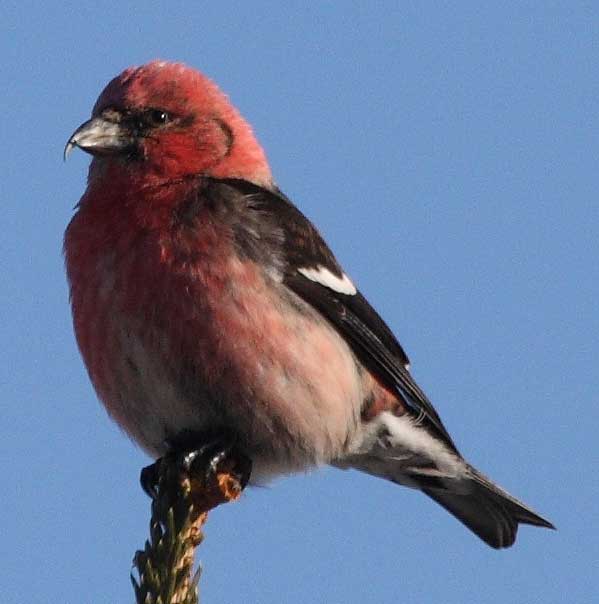
Loxia leucoptera, Photo: Dominic Sherony (*)
Cladus: Eukaryota
Supergroup: Opisthokonta
Regnum: Animalia
Subregnum: Eumetazoa
Cladus: Bilateria
Cladus: Nephrozoa
Cladus: Deuterostomia
Phylum: Chordata
Subphylum: Vertebrata
Infraphylum: Gnathostomata
Superclassis: Tetrapoda
Classis: Aves
Subclassis: Carinatae
Infraclassis: Neornithes
Parvclassis: Neognathae
Ordo: Passeriformes
Subordo: Passeri
Parvordo: Passerida
Superfamilia: Passeroidea
Familia: Fringillidae
Genus: Loxia
Species: Loxia leucoptera
Name
Loxia leucoptera Gmelin, 1789
Vernacular names
Internationalization
Български: Белокрила кръсточовка
English: Two-barred Crossbill
Lietuvių: Margasparnis kryžiasnapis
Polski: Krzyżodziób modrzewiowy
Suomi: Kirjosiipikäpylintu
Svenska: Bändelkorsnäbb
The Two-barred Crossbill (Loxia leucoptera), known as the White-winged Crossbill in North America, is a small passerine bird in the finch family Fringillidae. It has two subspecies, White-winged Crossbill Loxia leucoptera leucoptera in North America, and Two-barred Crossbill Loxia leucoptera bifasciata in NE Europe and N Asia.
This bird breeds in the coniferous forests of Alaska, Canada, northernmost USA and across Asia extending into northeast Europe. It nests in conifers, laying 3-5 eggs.
This crossbill is mainly resident, but will irregularly irrupt south if its food source fails. The American race seems to wander more frequently than the Eurasian subspecies. This species will form flocks outside the breeding season, often mixed with other crossbills. It is a rare visitor to western Europe, usually arriving with an eruption of Common Crossbills.
The crossbills are characterised by the mandibles crossing at their tips, which gives the group its English name. They are specialist feeders on conifer cones, and the unusual bill shape is an adaptation to assist the extraction of the seeds from the cone. Two-barred Crossbill has a strong preference for larch (Larix), in Eurasia using Siberian larch (Larix sibirica) and Dahurian larch (L. gmelinii), and in North America Tamarack larch (L. laricina). It will also take Rowan Sorbus berries, and in North America, also Eastern Hemlock (Tsuga canadensis) and White spruce (Picea glauca) cones.
Adult males tend to be red or pinkish in colour, and females green or yellow, but there is much variation. Two-barred is easier to identify than other crossbills, especially in North America, where only Red Crossbill and this species occur, but some care is still needed.
Within its Eurasian range, this species is smaller-headed and smaller-billed than Parrot Crossbill and Scottish Crossbill, so the main confusion species both there and in North America is Common or Red Crossbill.
The main plumage distinction from Common Crossbills is the white wingbars which give this species its English and scientific names. There are also white tips to the tertials. The adult male is also a somewhat brighter (pinker) red than other male crossbills. Some Common Crossbills occasionally show weak white wingbars, so care is needed with the correct identification of this species. The chip call is weaker and higher than that of Common Crossbill.
Another crossbill on Hispaniola was previously treated as a subspecies, Loxia leucoptera megaplaga, but is now treated as a distinct species, Hispaniolan Crossbill, Loxia megaplaga. It is associated with the Hispaniolan pine Pinus occidentalis, and differs from Two-barred Crossbill in darker plumage and a stouter bill.
Exceptional southern vagrancy in America?
On 11 January 2007 a White-winged Crossbill was found dead in the parking lot at Long Pine Key Picnic Area in Everglades National Park, Florida. Current speculation is that the bird may have been hit by a recreational vehicle that was on its way south from the bird's natural range, and simply fell off after arrival in Florida. It is hoped that during the preparation of the specimen an examination of the bird's stomach contents could help prove or disprove this hypothesis. Alternatively, it is possible that the bird could have originated from the Hispaniolan population.[2]
References
1. ^ BirdLife International (2004). Loxia leucoptera. 2006. IUCN Red List of Threatened Species. IUCN 2006. www.iucnredlist.org. Retrieved on 12 May 2006. Database entry includes justification for why this species is of least concern
2. ^ Postings to Tropical Audubon Society Miami Bird Board, 12 January 2007. link to discovery message
Retrieved from "http://en.wikipedia.org/"
All text is available under the terms of the GNU Free Documentation License

